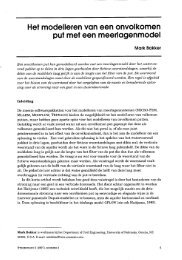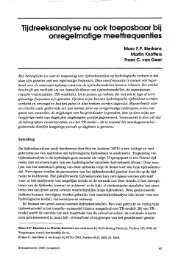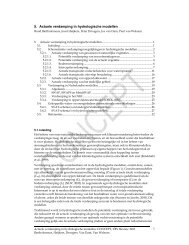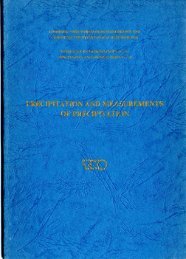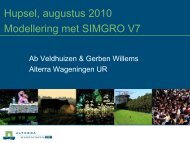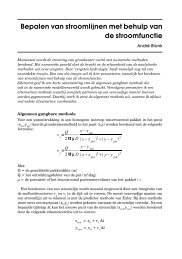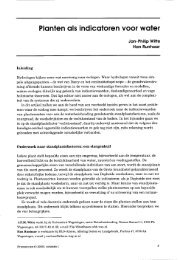Hydro-ecological relations in the Delta Waters
Hydro-ecological relations in the Delta Waters
Hydro-ecological relations in the Delta Waters
You also want an ePaper? Increase the reach of your titles
YUMPU automatically turns print PDFs into web optimized ePapers that Google loves.
that <strong>the</strong> predation pressure here is very high. This is also conf<strong>in</strong>md<br />
by <strong>the</strong> review paper of Baird, et al, 1988, and <strong>the</strong> tidal flats form a<br />
v- dist<strong>in</strong>ct ecosystem. Densities and comumptions of piscivores<br />
(tertiary consumers) are on average lower. Eemarkable is <strong>the</strong> high<br />
density and consumption <strong>in</strong> <strong>the</strong> sal<strong>in</strong>e lakes. These results fit more or<br />
lees <strong>in</strong> <strong>the</strong> concepts of <strong>ecological</strong> pyramids (Odm, 1872). From Bigure<br />
5, however, we see that a food web is a better description of <strong>the</strong><br />
reality, hence expla<strong>in</strong><strong>in</strong>g some deviations from <strong>the</strong> expected pyramid<br />
structure.<br />
5 PAIXOBS COMPWWING TAE RELUTON BETREEN DlSTRIBUTIDN AND FOOD<br />
SUPPLY<br />
From <strong>the</strong> previoudi section it is obvious that relatiens hetween bird<br />
density and food supply are hot always obvious. First of all <strong>the</strong> data<br />
of many spedes have been analysed rogecher. If wader densiries ii~<br />
gener&l are related to grey densities, it ia very likely that this<br />
holds also far most of <strong>the</strong> abundant species. However, if no rerrelatian<br />
is found for all birds of a hitd group, this does not me= that <strong>the</strong><br />
densities of iddividuaL species ma), not be closely l<strong>in</strong>k& ta <strong>the</strong>ir food<br />
supply. It is clear, however, that mt only food supply hut m), o<strong>the</strong>r<br />
variables may <strong>in</strong>fluence <strong>the</strong> distribution and density of birds. These<br />
factors may be purely <strong>ecological</strong> or result<strong>in</strong>g £ram human activities. We<br />
will try to briefly describe somg of <strong>the</strong>m <strong>in</strong> order to show <strong>the</strong><br />
qomplexity of <strong>the</strong> whole system and <strong>the</strong> difficulties one encounters <strong>in</strong><br />
prediet<strong>in</strong>g effects of impacts oq <strong>the</strong> ecosystem. We hope this will make<br />
clear that <strong>in</strong> plann<strong>in</strong>g we shvuld he very conservative and use very<br />
large marg<strong>in</strong>s concern<strong>in</strong>g enviromntal marters.<br />
5.1 Ecologital factors<br />
Migratien, large-scale distribntion patterns of a species and climatic<br />
oonditions are very important <strong>in</strong> determ<strong>in</strong><strong>in</strong>g bird numbers. Indeed for<br />
several species <strong>the</strong> <strong>Delta</strong> area forms ei<strong>the</strong>r che nor<strong>the</strong>rn or <strong>the</strong>





